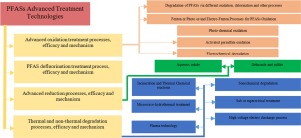当前位置:
X-MOL 学术
›
Process Saf. Environ. Prot.
›
论文详情
Our official English website, www.x-mol.net, welcomes your feedback! (Note: you will need to create a separate account there.)
Advanced Treatment Technologies Efficacies and Mechanism of Per- and Poly-Fluoroalkyl Substances Removal from Water
Process Safety and Environmental Protection ( IF 7.8 ) Pub Date : 2020-04-01 , DOI: 10.1016/j.psep.2020.01.005 Mohammad Boshir Ahmed , Md. Masruck Alam , John L. Zhou , Bentuo Xu , Md Abu Hasan Johir , Aneek Krishna Karmakar , Md. Saifur Rahman , Jewel Hossen , A.T.M. Kamrul Hasan , Mohammad Ali Moni
Process Safety and Environmental Protection ( IF 7.8 ) Pub Date : 2020-04-01 , DOI: 10.1016/j.psep.2020.01.005 Mohammad Boshir Ahmed , Md. Masruck Alam , John L. Zhou , Bentuo Xu , Md Abu Hasan Johir , Aneek Krishna Karmakar , Md. Saifur Rahman , Jewel Hossen , A.T.M. Kamrul Hasan , Mohammad Ali Moni

|
Abstract The increasing occurrence of chemically resistant per- and poly-fluoroalkyl substances (PFASs) in the natural environment, animal tissues and even the human body poses a significant health risk. Temporal trend studies on water, sediments, bird, fish, marine mammal and the human show that the exposure of PFAS has significantly increased over the last 20–30 years. Different physical, biological and chemical treatment processes have been investigated for PFAS removal from water. However, there is a lack of detailed understating of the mechanism of removal by different methods, especially by different advanced chemical treatment processes. This article reviews PFASs removal efficacy and mechanism by the advanced chemical treatment methods from aqueous solution. Review shows that several advanced oxidation processes (e.g., electrochemical oxidation, activated persulfate oxidation, photocatalysis, UV-induced oxidation) are successful in degrading PFASs. Moreover, defluorination treatment, some thermal and non-thermal degradation processes are also found to be prominent for the degradation of PFASs with some limitations including process costs over physical treatment (e.g., sorption), production of toxic by-products and greenhouse gases. Finally, knowledge gaps concerning the advanced chemical treatment of PFASs are discussed.
中文翻译:

先进处理技术从水中去除全氟和多氟烷基物质的功效和机理
摘要 在自然环境、动物组织甚至人体中越来越多地出现具有化学抗性的全氟和多氟烷基物质 (PFAS),这对健康构成了重大威胁。对水、沉积物、鸟类、鱼类、海洋哺乳动物和人类的时间趋势研究表明,PFAS 的暴露在过去 20-30 年间显着增加。已经研究了从水中去除 PFAS 的不同物理、生物和化学处理工艺。然而,缺乏对不同方法,特别是不同高级化学处理工艺的去除机制的详细了解。本文综述了先进化学处理方法对水溶液中PFASs的去除效果和机理。回顾表明,几种高级氧化过程(例如,电化学氧化、活化过硫酸盐氧化、光催化、紫外线诱导氧化)可成功降解 PFAS。此外,还发现脱氟处理、一些热和非热降解过程对于全氟和多氟烷基物质的降解也很突出,但存在一些限制,包括物理处理(例如吸附)的工艺成本、有毒副产品和温室气体的产生。最后,讨论了有关 PFAS 高级化学处理的知识差距。产生有毒副产品和温室气体。最后,讨论了有关 PFAS 高级化学处理的知识差距。产生有毒副产品和温室气体。最后,讨论了有关 PFAS 高级化学处理的知识差距。
更新日期:2020-04-01
中文翻译:

先进处理技术从水中去除全氟和多氟烷基物质的功效和机理
摘要 在自然环境、动物组织甚至人体中越来越多地出现具有化学抗性的全氟和多氟烷基物质 (PFAS),这对健康构成了重大威胁。对水、沉积物、鸟类、鱼类、海洋哺乳动物和人类的时间趋势研究表明,PFAS 的暴露在过去 20-30 年间显着增加。已经研究了从水中去除 PFAS 的不同物理、生物和化学处理工艺。然而,缺乏对不同方法,特别是不同高级化学处理工艺的去除机制的详细了解。本文综述了先进化学处理方法对水溶液中PFASs的去除效果和机理。回顾表明,几种高级氧化过程(例如,电化学氧化、活化过硫酸盐氧化、光催化、紫外线诱导氧化)可成功降解 PFAS。此外,还发现脱氟处理、一些热和非热降解过程对于全氟和多氟烷基物质的降解也很突出,但存在一些限制,包括物理处理(例如吸附)的工艺成本、有毒副产品和温室气体的产生。最后,讨论了有关 PFAS 高级化学处理的知识差距。产生有毒副产品和温室气体。最后,讨论了有关 PFAS 高级化学处理的知识差距。产生有毒副产品和温室气体。最后,讨论了有关 PFAS 高级化学处理的知识差距。



























 京公网安备 11010802027423号
京公网安备 11010802027423号